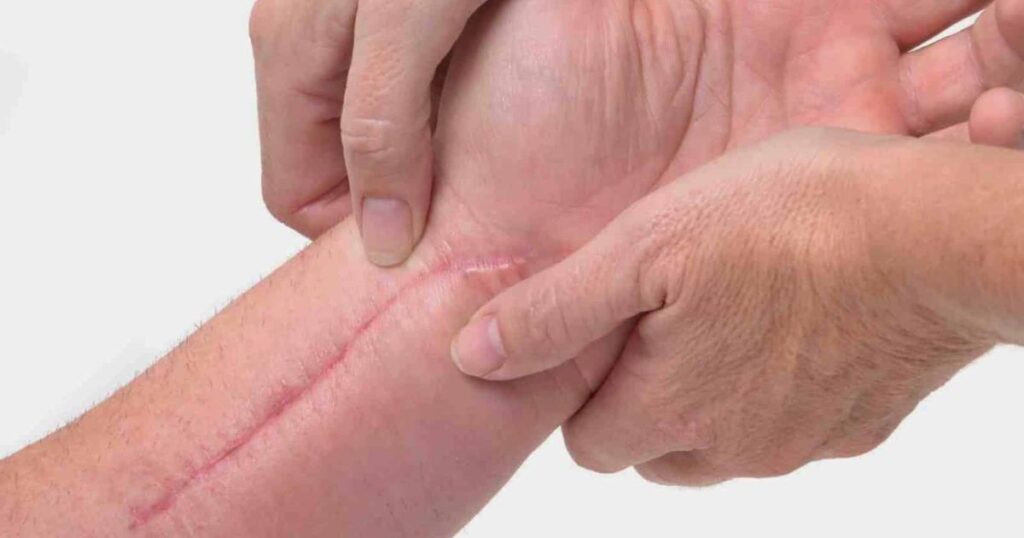When you need stitches waiting hours in a hospital emergency room is not always an option. Urgent care centers offer a faster more affordable solution for treating cuts and wounds.
In this guide we will explore how urgent care clinics handle stitches what you can expect during the process and how to take care of your wound after getting stitched up. Whether you are dealing with a minor injury or a deeper cut this guide will help you feel prepared and confident.
The Lowdown on Stitches
What Exactly Are Stitches?
Stitches, also known as sutures, are medical devices used to hold together the edges of a wound or surgical incision. They’re essentially the body’s version of fabric thread, helping to close gaps in the skin and promote proper healing.
Read More: What is Caseoh Real Name? Full Biography 2024
When Do You Need Them?
Not every cut requires stitches. Here’s a quick checklist to help you determine when to get stitches.
- The wound is deeper than 1/4 inch
- You can see fat, muscle, or bone
- The cut is longer than 3/4 inch
- It’s on a part of the body that moves a lot (like joints)
- The bleeding doesn’t stop after 10 15 minutes of direct pressure
- It’s a facial wound
Types of Stitches More Than Just Thread and Needle
Modern medicine offers various types of stitches, each suited for different wounds and body parts:
- Absorbable sutures: These dissolve over time and don’t need removal.
- Non-absorbable sutures: Require removal by a healthcare professional.
- Staples: Quick to apply, ideal for scalp wounds.
- Skin glue: Perfect for small, clean cuts.
- Steri-strips: Adhesive strips for minor wounds.
Read More: The Story of Gypsy Rose Blanchard and Her Mother
Urgent Care vs. ER: Where Should You Go?

Assessing Your Injury: Is It Urgent Care-Worthy?
Most cuts requiring stitches can be handled at an urgent care wound treatment center. Some situations call for a trip to the emergency room.
Urgent Care is suitable for:
- Clean cuts less than 1 inch deep
- Wounds that aren’t actively spurting blood
- Injuries more than 2 hours old (but less than 24 hours)
Emergency Room is necessary for:
- Deep puncture wounds
- Animal or human bites
- Wounds with embedded objects
- Cuts near the eye or involving tendons
Benefit of Choosing Urgent Care for Stitches
- Sshorter wait times: On average you will wait 15 45 minutes at urgent care compared to 2+ hours at the ER.
- Lower costs: Stitches cost significantly less at urgent care centers.
- Focused care: Urgent cares specialize in non life threatening injuries like cuts.
When the ER is Your Best Bet
While urgent care centers are great for many situations, some injuries require the advanced capabilities of an emergency room. Always err on the side of caution if you’re unsure.
If in doubt head to the ER. It is better to be safe than sorry when it comes to serious injuries. Dr. Sarah Johnson Emergency Medicine Specialist
The Urgent Care Stitch Experience

What to Expect When You Walk In
- Check in and triage
- Brief medical history review
- Wound examination
- Treatment plan discussion
The Step by Step Process
- Cleaning: The wound area is thoroughly cleaned to prevent infection.
- Anesthesia: Local anesthesia is applied to numb the area.
- Suturing: The healthcare provider closes the wound with appropriate sutures.
- Dressing: A sterile dressing is applied to protect the wound.
- Aftercare instructions: You’ll receive detailed care instructions.
Pain Management: It’s Not as Bad as You Think
Thanks to local anesthesia, getting sutures urgent care is typically a painless process. You might feel some pressure, but actual pain should be minimal.
Insurance Coverage: What You Need to Know
Most insurance plans cover urgent care stitches, but always check your policy. Some key points:
- Copays are typically lower for urgent care visits
- You may need to meet a deductible first
- Some plans require pre-authorization for certain treatments
Payment Options for the Uninsured
If you’re uninsured, don’t let that stop you from seeking necessary care. Many urgent care centers offer:
- Sliding scale fees based on income
- Payment plans
- Discounts for upfront cash payments
After the Stitches: The Road to Recovery
Caring for Your New Stitches

- Keep the wound clean and dry for the first 24-48 hours
- Gently wash around the stitches with mild soap and water after 48 hours
- Apply antibiotic ointment as directed
- Cover with a clean bandage if the wound might get dirty or irritated
Red Flags: When to Worry
Seek medical attention if you notice:
- Increasing pain or redness
- Swelling or warmth around the wound
- Pus or unusual drainage
- Fever
- The stitches come loose or fall out early
The Removal Process: Timing is Everything
Stitches are typically removed after 5-14 days, depending on the location and severity of the wound. Here’s a general timeline:
- Face: 3-5 days
- Scalp: 7-10 days
- Arms and legs: 10-14 days
- Chest or back: 10-14 days
Stitch Alternatives: Modern Medicine’s Got Options
Skin Glue: When Humpty Dumpty Meets Science
Skin adhesives like Dermabond are perfect for clean, straight cuts. They’re quick to apply and don’t require removal.
Pros:
- No needle required
- Quick application
- Water-resistant
Cons:
- Not suitable for all wound types
- Can be more expensive than traditional sutures
Staples: Not Just for Paper Anymore
Surgical staples are often used for scalp wounds or long, straight cuts on the body.
Pros:
- Quick to apply
- Ideal for thick skin areas
- Less likely to cause skin reactions
Cons:
- Can be more painful to remove
- May leave more noticeable scars
Steri-strips: The Minimalist Approach
These adhesive strips are perfect for minor cuts or as a follow-up to removed stitches.
Pros:
- No pain during application or removal
- Can be applied at home for minor wounds
- Inexpensive
Cons:
- Not suitable for deep or wide wounds
- May come off too soon in high-movement areas
Preventing the Need for Stitches
Safety First: Avoiding Common Accidents
- Use proper protective equipment when working with tools
- Keep knives sharp dull knives are more likely to slip
- Be cautious on wet or slippery surfaces
- Childproof your home to prevent accidents
First Aid Basics: What to Do Before You Get Help
- Apply direct pressure to stop bleeding
- Clean the wound with cool water
- Apply an antibiotic ointment if available
- Cover with a clean, dry dressing
When DIY Just Won’t Cut It
While minor cuts can be treated at home it is crucial to recognize when professional help is needed. Do not hesitate to seek medical attention if you are unsure.
Finding the Right Urgent Care for Stitches
What to Look for in a Quality Urgent Care Center
- Board-certified physicians
- Clean, modern facilities
- Transparent pricing
- Positive patient reviews
- Convenient hours and location
Questions to Ask Before You Go
- Do you offer stitches for my type of wound?
- What are your hours of operation?
- Do you accept my insurance?
- What’s the estimated wait time?
- Do you offer follow-up care?
Real Talk: Patient Stories and Experiences
Case Study: Sarah’s Kitchen Mishap
Sarah, a 32-year-old chef sliced her finger while prepping for dinner service. She shares her experience.
I was terrified of getting stitches but the urgent care staff was incredible. They explained everything used a numbing spray before the local anesthetic and I barely felt a thing. The whole process took less than an hour, and I was back at work the next day with a cool story to tell.
Lessons Learned: What Patients Wish They’d Known
- I wish I’d known how quick and painless it would be.
- I should have gone sooner instead of trying to handle it myself.
- The cost was much lower than I expected especially compared to the ER.
The Psychological Impact: Dealing with Sudden Injuries
It is normal to feel anxious or stressed after an injury. Some tips for coping:
- Practice deep breathing exercises
- Talk to friends or family about your experience
- Focus on the healing process and positive outcomes
- Consider speaking with a counselor if anxiety persists
The Future of Wound Care
Emerging Technologies in Stitching
- Smart sutures: Embedded with sensors to detect infection
- Nanofiber sutures: Mimic natural tissue for better healing
- 3D-printed adhesives: Custom-designed for each wound
Telemedicine and Wound Assessment
Virtual consultations are becoming more common for initial wound assessment and follow-up care. This can help determine if in-person treatment is necessary and provide ongoing care instructions.
What’s Next for Urgent Care Services?
Urgent care centers continue to expand their services with some offering:
- On-site X-rays and lab testing
- Specialized wound care clinics
- Extended hours and weekend services
Conclusion
Getting stitches doesn’t have to be a stressful or expensive experience. Urgent care clinics are there to make sure you receive proper wound care without the long wait times or high costs of an ER visit.
With the right care most stitches heal quickly and leave minimal scarring. If you find yourself needing stitches, remember that urgent care is a reliable and convenient option to get you back on your feet in no time.







